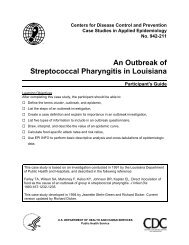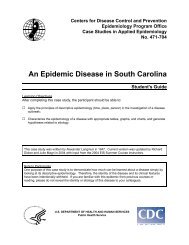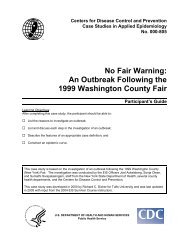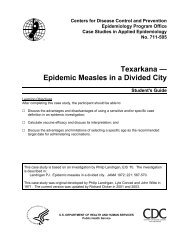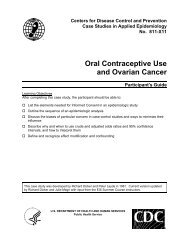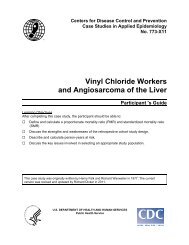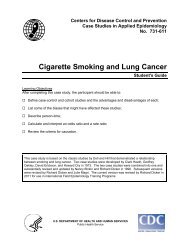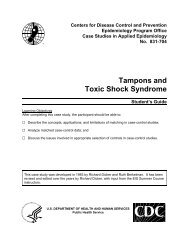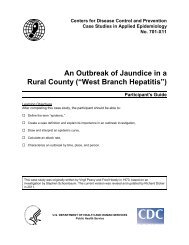Outbreak of Type A Botulism and Development of a ... - Library
Outbreak of Type A Botulism and Development of a ... - Library
Outbreak of Type A Botulism and Development of a ... - Library
You also want an ePaper? Increase the reach of your titles
YUMPU automatically turns print PDFs into web optimized ePapers that Google loves.
LETTER FROMBUENOS AIRES<strong>Outbreak</strong> <strong>of</strong> <strong>Type</strong> A <strong>Botulism</strong> <strong>and</strong><strong>Development</strong> <strong>of</strong> a <strong>Botulism</strong> Surveillance<strong>and</strong> Antitoxin Release System in ArgentinaRodrigo G. Villar, MDRoger L. Shapiro, MDSilvina Busto, MD, MPHClara Riva-Posse, MD, MPHGuadalupe Verdejo, MD, MPHMaria Isabel Farace, DVMFrancisco Rosetti, MSJorge A. San Juan, MDCarlos Maria Julia, MD, MPHJohn Becher, RPhSusan E. Maslanka, PhDDavid L. Swerdlow, MDContext <strong>Botulism</strong> is an important public health problem in Argentina, but obtainingantitoxin rapidly has been difficult because global supplies are limited. In January 1998,a botulism outbreak occurred in Buenos Aires.Objectives To determine the source <strong>of</strong> the outbreak, improve botulism surveillance,<strong>and</strong> establish an antitoxin supply <strong>and</strong> release system in Argentina.Design, Setting, <strong>and</strong> Participants Cohort study in January 1998 <strong>of</strong> 21 drivers <strong>of</strong>a specific bus route in urban Buenos Aires.Main Outcome Measure Occurrence <strong>of</strong> botulism <strong>and</strong> implication <strong>of</strong> a particularfood as the vehicle causing this outbreak.Results Nine (43%) <strong>of</strong> 21 bus drivers developed botulism, presenting with gastroenteritis,symptoms <strong>of</strong> acute cranial nerve dysfunction including ptosis, dysphagia, blurredvision, <strong>and</strong> motor weakness. One driver experienced respiratory failure. <strong>Type</strong> A toxinwas detected from 3 <strong>of</strong> 9 patients’ serum samples. All drivers received botulism antitoxin;there were no fatalities. Consumption <strong>of</strong> matambre (Argentine meat roll) wassignificantly associated with illness. Among 11 persons who ate matambre, 9 developedillness, compared with none <strong>of</strong> those who did not eat it (P.001). The matambrehad been cooked in water at 78°C to 80°C for 4 hours, sealed in heat-shrinkedplastic wrap, <strong>and</strong> stored in refrigerators that did not cool adequately. Subsequently, abotulism surveillance <strong>and</strong> antitoxin release system was established.Conclusions Insufficient cooking time <strong>and</strong> temperatures, storage in heat-shrinkedplastic wrap, <strong>and</strong> inadequate refrigeration likely contributed to Clostridium botulinumspore survival, germination, <strong>and</strong> toxin production. A rapid-response botulism surveillance<strong>and</strong> antitoxin release system in Argentina should provide more timely distribution<strong>of</strong> antitoxin to patients <strong>and</strong> may serve as a model for other nations.JAMA. 1999;281:1334-1338, 1340www.jama.comAuthor Affiliations: Foodborne <strong>and</strong> Diarrheal DiseasesBranch (Villar, Shapiro, Maslanka, <strong>and</strong> Swerdlow), ScientificResources Program (Becher), National Center forInfectious Diseases (Villar, Shapiro, Maslanka, Swerdlow,<strong>and</strong> Becher), Epidemic Intelligence Service, EpidemiologyProgram Office (Villar <strong>and</strong> Shapiro), Centersfor Disease Control <strong>and</strong> Prevention, Atlanta, Ga (Villar,Shapiro, Maslanka, Swerdlow, <strong>and</strong> Becher); Ministeriode Salud-Region V (Busto) <strong>and</strong> Ministerio de Salud y AccionSocial (Riva-Posse <strong>and</strong> Julia), Medicina SanitariaBOTULISM IS A POTENTIALLY FAtal,neuroparalytic illness resultingfrom toxins produced by thebacterium Clostridium botulinum. 1,2 Humanillness occurs as infant botulism,botulism from intestinal colonization<strong>and</strong> wound infections, <strong>and</strong> foodbornebotulism. 3 Symptoms appear approximately12 to 36 hours after toxin exposurebeginning with bulbar <strong>and</strong> autonomicnervous system disturbances.Descending, symmetrical skeletalmuscle weakness, paralysis, <strong>and</strong> respiratoryfailure may also follow, 4,5 whichrequire prompt, supportive therapy includingmechanical ventilation. 5,6 <strong>Botulism</strong>antitoxin, the only specific therapyavailable to ameliorate illness, can helpprevent progression <strong>of</strong> paralysis, reduceduration <strong>of</strong> illness, <strong>and</strong> decreasefatality rates. 7Supportive care <strong>and</strong> prompt administration<strong>of</strong> antitoxin have reduced mortalityin the United States to less than10%, 8 <strong>and</strong> prompt identification <strong>of</strong> suspectfood vehicles during outbreaks hasprevented additional cases <strong>and</strong> reshapedour underst<strong>and</strong>ing <strong>of</strong> the epidemiology<strong>of</strong> botulism. Global antitoxinsupplies are limited <strong>and</strong> antitoxinhas been unavailable for immediate usein several recent outbreaks (eg, Italy <strong>and</strong>Egypt). 9,10 In the United States, the Cen-(Julia), Direccion de Epidemiologia (Riva-Posse), PanAmerican Health Organization (Verdejo), Departamentode Bacteriologia, Instituto Nacional de Enfermedades Infecciosas,ANLIS Carlos G. Malbran (Farace <strong>and</strong> Rosetti),Hospital F. J. Muñiz (San Juan), Buenos Aires, Argentina.Corresponding Author: David L. Swerdlow, MD, Centersfor Disease Control <strong>and</strong> Prevention, 1600 Clifton Rd(MS A-38), Atlanta, GA 30333.Edited by Annette Flanagin, RN, MA, Associate SeniorEditor.1334 JAMA, April 14, 1999—Vol 281, No. 14 ©1999 American Medical Association. All rights reserved.Downloaded from jama.ama-assn.org at CDC-Information Center on December 28, 2011
LETTER FROM BUENOS AIRESters for Disease Control <strong>and</strong> Prevention(CDC) maintains surveillance <strong>of</strong>botulism cases <strong>and</strong> operates an antitoxinrelease system. This system dependson a centralized, 24-hour emergency-responsetelephone number forthe release <strong>of</strong> antitoxin throughout thecountry <strong>and</strong> is coordinated at federal,state, <strong>and</strong> local levels to identify suspectfood items <strong>and</strong> prevent additionalcases. The CDC manages a stock<strong>of</strong> antitoxin <strong>and</strong> distributes it for emergencyuse domestically <strong>and</strong> in membernations <strong>of</strong> the Pan-American HealthOrganization. 11Foodborne botulism most commonlyoccurs following the ingestion<strong>of</strong> improperly canned or preservedfoods that contain preformed toxin. 12,13For foodborne botulism to occur, Cbotulinum spores must be present in thefood <strong>and</strong> these spores must survive processing.The food or its packaging mustprovide an environment suitable forspores to germinate <strong>and</strong> produce toxin,<strong>and</strong> finally, persons must consume thefood without heating it to temperaturessufficient to destroy the heatlabileC botulinum toxin. 2An environment favorable to C botulinummay occur when foods are preservedby inexperienced persons, whenfaulty equipment is used, or when acontaminated product not intended forlong-term preservation is mish<strong>and</strong>ledor packaged in a manner that permitsspores to germinate. New vacuumpackagingtechniques including sousvide <strong>and</strong> heat-shrinked plastic wraphave raised concern about the possibility<strong>of</strong> botulism occurring from foodspackaged in these reduced oxygen environments2,14,15 ; however, few publisheddata on this risk exist.On January 13, 1998, an infectiousdiseases physician in a Buenos Aireshospital observed 2 men presentingwith ptosis, diplopia, dysphagia, <strong>and</strong>respiratory difficulties <strong>and</strong> notified theDirectorate <strong>of</strong> Epidemiology <strong>of</strong> the ArgentineMinistry <strong>of</strong> Health about a possiblebotulism outbreak. Both men werebus drivers for the same company whodrove the same route <strong>and</strong> morning shift.Health <strong>of</strong>ficials identified 5 other driversfrom the same company <strong>and</strong> shiftwho also had neurologic signs consistentwith botulism. Initial reports suggestedthat all the drivers had eaten ata home located on the bus route wherethe drivers stopped during their breaks.Epidemiologists from the ArgentineMinistry <strong>of</strong> Health called the Foodborne<strong>and</strong> Diarrheal Diseases Branch,National Center for Infectious Diseases,at the CDC to report the outbreak<strong>and</strong> request botulism antitoxinto treat these patients <strong>and</strong> possibly othersexposed to an unknown contaminatedfood source. In this article, we reportthe outbreak investigation <strong>and</strong>discuss how the preparation, storage,<strong>and</strong> packaging <strong>of</strong> the implicated foodmay have permitted C botulinum sporesto germinate.In addition to investigating the outbreak<strong>and</strong> reviewing the epidemiology<strong>of</strong> botulism in Argentina, the ArgentineMinistry <strong>of</strong> Health <strong>and</strong> the CDCused this opportunity to establish a localsystem for botulism surveillance <strong>and</strong>antitoxin distribution. The goals <strong>of</strong> thesystem are to reinforce surveillance, todeliver antitoxin to patients in Argentinamore rapidly <strong>and</strong> efficiently, <strong>and</strong>to serve as a model for other nations.METHODSCase Identification <strong>and</strong>Cohort StudyTo identify cases, all employees <strong>of</strong> thebus company with the ill drivers werecontacted. Hospitals in the areas <strong>of</strong> BuenosAires where cases occurred <strong>and</strong>where a suspected food was producedwere asked to report any patients withacute neurologic illness that could bebotulism. Additionally, the outbreakwas reported by the local news media.We conducted a cohort study amongbus drivers who were ill <strong>and</strong> also thosewho were well who drove the morningshift <strong>of</strong> the bus route. On January18-19, 1998, we conducted face-t<strong>of</strong>aceinterviews <strong>and</strong> administered a writtenquestionnaire to the drivers. Weasked drivers about demographic characteristics,symptoms, <strong>and</strong> food exposuresduring the probable exposure period.We defined a confirmed case <strong>of</strong>botulism as a serum or stool sample thatdemonstrated botulinum toxin oryielded C botulinum from a bus driveron the morning shift who ate or drankat the home terminal stop betweenJanuary 3 <strong>and</strong> 7. Probable illness wasdefined as acute cranial nerve dysfunctionin this group <strong>of</strong> drivers during thisperiod. We excluded drivers from othershifts because none reported illness <strong>and</strong>they did not eat at the terminal stop orshare any other common food exposureswith the morning shift drivers.Data were analyzed <strong>and</strong> relative riskswith Fisher exact P values <strong>and</strong> 95% confidenceintervals were calculated usingEpi Info version 6.04a (Centers forDisease Control <strong>and</strong> Prevention, Atlanta,Ga) <strong>and</strong> Exact S<strong>of</strong>tware (theNetherl<strong>and</strong>s). 16 Values <strong>of</strong> P.05 <strong>and</strong>95% confidence intervals that did notinclude 1 were considered significant.Environmental InvestigationWe interviewed the family living in thehouse where the drivers ate, asked whatfoods <strong>and</strong> drinks were served, <strong>and</strong> inspectedthe food preparation <strong>and</strong> storagefacilities. We also inspected the supermarketwhere the foods werepurchased <strong>and</strong> the facility where a suspectedfood was produced.Microbiologic InvestigationSerum specimens were collected fromall patients between January 13 <strong>and</strong> 16,<strong>and</strong> stool specimens were obtained frompatients between January 18 <strong>and</strong> 20 forboth toxin <strong>and</strong> culture testing for Cbotulinum. Assays were conducted in thediagnostics <strong>and</strong> food laboratory forbotulism <strong>of</strong> the Instituto Nacional deEnfermedades Infecciosas, BuenosAires. Approximately 10 to 40 g <strong>of</strong> patients’feces with an equivalent volume<strong>of</strong> diluent gelatin were ground insterile mortars. The solution reposed for12 to 18 hours at 4°C to allow any toxinpresent to transfer into the liquid medium.It was then centrifuged at 12 000rpm for 20 minutes.Toxicity <strong>and</strong> neutralization assayswere conducted in duplicate usingwhite mice weighing 18 to 20 g. Foreach mouse, 0.1 mL <strong>of</strong> monovalent an-©1999 American Medical Association. All rights reserved. JAMA, April 14, 1999—Vol 281, No. 14 1335Downloaded from jama.ama-assn.org at CDC-Information Center on December 28, 2011
LETTER FROM BUENOS AIRESThe market purchased matambresfrom a small-scale, commercial producerwho made matambres <strong>and</strong> processedhams at his home. To makematambre, the producer placed a slab <strong>of</strong>raw beef (1- to 3-cm thick) on a stainlesssteel table. Ingredients included rawsliced carrots, hard-boiled eggs, salt, redpepper flakes, dried oregano, <strong>and</strong> commercialpotato flour. The meat was rolledup around the vegetables <strong>and</strong> eggs tomake an approximately 10- 30-cmcylinder. This meat roll was placed intoa rectangular stainless steel pan to keepingredients inside during cooking. Between10 <strong>and</strong> 15 matambres in individualsteel pans were immersed togetherinto water heated to 78°C to 80°C(never boiling), <strong>and</strong> cooked for approximately4 hours. After cooking, the waterwas drained <strong>and</strong> the producers reportedthey checked each matambre toensure an internal temperature <strong>of</strong> about68°C. The producer placed each warmmatambre in heat-shrinked plastic wrap,squeezed out the air, <strong>and</strong> sealed the plasticwith heat. The plastic-wrappedmatambres were allowed to cool, placedin a walk-in refrigerator, <strong>and</strong> were storedfor up to 2 weeks before being sold toeither supermarkets or directly to consumers.The producer reported makingmatambres every 2 weeks in batches<strong>of</strong> 15 to 20 each time; the last batch producedbefore the outbreak was made inearly December. The producer was unableto provide receipts or a distributionlist with names <strong>of</strong> locations wherehis products were sold. He reported thatmost <strong>of</strong> his clients distributed his productsin the western greater Buenos Airesarea. After an inspection by local foodsafety <strong>of</strong>ficials, the facility was closed.Laboratory InvestigationThe mouse assay for botulism toxin presencewas performed with serum fromeach patient; 3 were positive for toxintype A. None <strong>of</strong> the stool cultures yieldedC botulinum. No implicated matambrewas available for testing.Table 2. Foods Consumed by Bus Drivers (n = 21) in Buenos Aires, Argentina,in January 1998*No./Total (%)Food Item Ate Food Did Not Eat FoodRelative Risk(95% Confidence Interval)PValueMatambre 9/11 (82) 0/10 (0) Undefined (4.37-) .01Bologna 1/1 (100) 8/20 (40) 2.50 (1.46-4.28) .43Mate 4/8 (50) 5/8 (63) 1.30 (0.49-3.45) .67Hot dog 1/2 (50) 8/19 (42) 1.19 (0.27-5.23) .99Salami 1/2 (50) 8/19 (42) 1.19 (0.27-5.23) .99Solid ham 2/5 (40) 7/16 (44) 0.86 (0.26-2.85) .99Processed ham 2/5 (40) 7/16 (44) 0.86 (0.26-2.85) .99*Matambre is the traditional meat roll in Argentina <strong>and</strong> mate is green tea.COMMENTWe reported an outbreak <strong>of</strong> botulismamong bus drivers in Buenos Aires, Argentina,caused by consumption <strong>of</strong>matambre, a food that has not been describedpreviously as a vehicle for botulism.A cohort study determined thatall ill persons ate slices <strong>of</strong> a singlematambre; no other foods were associatedwith illness. <strong>Type</strong> A toxin was identifiedfrom 3 <strong>of</strong> 9 patients’ serumsamples. Unfortunately, no implicatedmatambre was available for laboratoryanalysis.Although consumption <strong>of</strong> matambreis an established tradition in Argentina,it is usually consumed fresh<strong>and</strong> is not generally intended for picklingor long-term preservation. Matambresproduced by licensed, commercialfacilities use nitrites, acidifiers, orother preservatives to prevent bacterialgrowth; the implicated matambrelacked these. Insufficient cooking,vacuum packaging in heat-shrinkedplastic wrap, <strong>and</strong> inadequate refrigerationmay have provided conditions forlive spores to germinate <strong>and</strong> producetoxin. To our knowledge, this is the firsttime heat-shrinked plastic wrap hasbeen linked to botulism, emphasizingconcern about the safety <strong>of</strong> this packagingmethod.The matambre that is believed to bethe cause <strong>of</strong> this outbreak was cookedat relatively low temperatures (78°C-80°C) over a time period (approximately240 minutes) too short to killall C botulinum spores. These spores aredifficult to destroy using conventionalcooking techniques; temperature survivalcurves have demonstrated C botulinumsurvival at 80°C for more than270 minutes. 17 In fact, a nonkilling heatshock <strong>and</strong> the lack <strong>of</strong> preservatives oracidifiers may enhance germination <strong>and</strong>toxin elaboration by C botulinumspores. 2,13,18 To safely prepare foods intendedfor canning or long-term storage,the US Department <strong>of</strong> Agriculturerecommends that all low-acid foods(foods with pH 4.6, including redmeats, seafood, poultry, milk, <strong>and</strong> freshvegetables) be sterilized at temperatures<strong>of</strong> 116°C to 121°C in pressure cannersoperated at 0.68 to 0.97 atm (10-15lb/in 2 ). At these temperatures, the timeneeded to destroy bacteria in low-acidcanned food ranges from 20 to 100 minutes.The exact time depends on thekind <strong>of</strong> food being canned, the way itis packed, <strong>and</strong> the amount <strong>of</strong> food beingcooked. The time needed to safelyprocess low-acid foods in boiling watercanners ranges from 7 to 11 hours. 14The time <strong>and</strong> temperatures used to cookthe matambre in this outbreak were insufficientto kill all botulism spores.Reduced oxygen packaging <strong>of</strong> foodscanincreasetherisk<strong>of</strong>certainfoodborneillnesses if other safety barriers have notbeenapplied. 15,19 Althoughvacuumpackagingmay inhibit the growth <strong>of</strong> sometypes <strong>of</strong> bacteria in foods, several Clostridiumspecies can grow <strong>and</strong> producetoxininthisenvironment. 2,20-22 Toreducetherisk<strong>of</strong>botulismfromfoodsinreducedoxygenpackaging,theUSFood<strong>and</strong>DrugAdministrationrequiresdocumentedemployeetraininginplantsthatusereducedoxygenpackaging,stringentrefrigeration,specificlabelingwithstoragetemperatureinstructions <strong>and</strong> use-by dates, <strong>and</strong> plantapproval for reduced oxygen packaging<strong>of</strong> fish, s<strong>of</strong>t cheeses, meats, <strong>and</strong> poultry. 15©1999 American Medical Association. All rights reserved. JAMA, April 14, 1999—Vol 281, No. 14 1337Downloaded from jama.ama-assn.org at CDC-Information Center on December 28, 2011
LETTER FROM BUENOS AIRESThematambreinthisoutbreakwaspackagedin a reduced oxygen environment<strong>and</strong> lacked other safety barriers neededto prevent Clostridium spores from proliferating.Inadequate refrigeration also provideda favorable growth environmentfor C botulinum. The refrigerators (attemperatures between 9°C-10°C) usedto store the matambre at the terminalstop were not cold enough for safe storage<strong>of</strong> perishable foods. 18,23 The US Food<strong>and</strong> Drug Administration recommendsthat refrigerator temperatures be5°C or colder to prevent the growth <strong>of</strong>C botulinum in foods stored in reducedoxygen packaging. 15 Maintenance<strong>of</strong> adequate storage temperaturesfor the matambre also was notdocumented by the producer or themarket where it was sold.The clinical characteristics <strong>of</strong> botulismamong patients in this outbreak differedin several respects from those inother reports. 1,3,4 Typically, most patientswith botulism develop severe muscularweakness <strong>and</strong> mild gastroenteritis.In this outbreak, the majority <strong>of</strong>patients experienced severe gastroenteritis,<strong>and</strong> only 1 patient developed severemuscular paralysis. In US cases <strong>of</strong>type A botulism, the reported median incubationperiod was 1 day (range, 0-5days). 3 In the Argentine outbreak, the incubationperiod was longer; the mediantime between food exposure <strong>and</strong> onset<strong>of</strong> neurologic symptoms onset was 5days (range, 0-10 days). Several reportedoutbreaks <strong>of</strong> botulism from Europehave described patients with primarilymild to moderate symptoms, butmost <strong>of</strong> these outbreaks have been causedby type B toxin. 24-26 It is not known whysome strains <strong>of</strong> C botulinum cause milderillness than others, although the numbers<strong>of</strong> spores present <strong>and</strong> amount <strong>of</strong>toxin produced <strong>and</strong> ingested may influenceclinical manifestations. The severity<strong>of</strong> gastroenteritis experienced by thesepatients could have also occurred if thematambre had been contaminated byother bacteria or toxins.The outbreak investigation had severallimitations. All <strong>of</strong> the implicatedmatambre had been consumed <strong>and</strong> allremaining matambres from the supermarketwhere the implicated meat waspurchased were discarded before the investigationbegan. Although no matambreswere available for laboratory analysis,epidemiologic data <strong>and</strong> informationgained from the investigation implicatedthe product. Furthermore, receiptswere unavailable from the supermarketor the matambre producer todocument dates <strong>of</strong> purchase or exactdistribution <strong>of</strong> the product. However,no additional cases <strong>of</strong> type A botulismwere detected.The use <strong>of</strong> heat-shrinked plastic wrap<strong>and</strong> vacuum packaging for cookedfoods followed by inappropriate refrigerationmay provide an ideal environmentfor the growth <strong>of</strong> C botulinum, <strong>and</strong>the safety <strong>of</strong> these packaging methodsshould be further investigated. Education<strong>of</strong> food manufacturers <strong>and</strong> distributors,including the importance <strong>of</strong>adequate cooking time <strong>and</strong> temperaturesto kill C botulinum spores, addingacidifiers or preservatives to foodsintended for prolonged shelf life <strong>and</strong> refrigeratingfoods properly, may helpprevent such outbreaks.Enhancing Surveillance<strong>and</strong> Establishing an AntitoxinRelease System<strong>Botulism</strong> is an important public healthproblem in Argentina. Data maintainedby the Argentine Ministry <strong>of</strong> Health indicatethat during the years 1979-1997,277 cases <strong>of</strong> botulism were reported inArgentina (Ministry <strong>of</strong> Health, Republic<strong>of</strong> Argentina, unpublished data, 1998).Between 1987 <strong>and</strong> 1997, the CDC released54 vials <strong>of</strong> antitoxin to Argentina(CDC, unpublished data, 1998). In 1997,23 patients with suspected foodbornebotulism were reported in Argentina,about the same number <strong>of</strong> laboratoryconfirmedcases per year as in the UnitedStates, 27 which has a population approximately10 times that <strong>of</strong> Argentina. In addition,11 cases <strong>of</strong> culture-confirmed infantbotulism were reported in Argentinathat year. Only 1 case <strong>of</strong> wound botulismhas been described in Argentina. Of89 laboratory-confirmed cases reportedbetween 1991 <strong>and</strong> 1997, 83 (93%) wereidentified as toxin type A, 4 (5%) as toxintype E (all occurred in a single outbreak),<strong>and</strong> 2 (2%) as toxin type B (Ministry<strong>of</strong> Health, Republic <strong>of</strong> Argentina,unpublished data, 1998). In the UnitedStates, toxin types A, B, <strong>and</strong> E were identifiedin 60%, 30%, <strong>and</strong> 10% <strong>of</strong> cases, respectively.3,8,27Previous outbreaks in Argentina havebeen caused primarily through the consumption<strong>of</strong> improperly preserved vegetables<strong>and</strong> meats. Although C botulinumspores are ubiquitous, they arefound most frequently in soil samples.The level <strong>of</strong> Clostridium species contaminationon vegetables, particularlythose harvested directly from soil, isgenerally higher than that found inmeats 2 <strong>and</strong> may in part explain why preservedvegetables are more frequentlyimplicated.Because <strong>of</strong> the relatively high incidence<strong>of</strong> botulism in Argentina, the Ministry<strong>of</strong> Health <strong>and</strong> the CDC collaboratedto establish, in January 1998, anantitoxin release <strong>and</strong> surveillance systemfor botulism in Argentina based onthe US program. The system componentsinclude (1) establishment <strong>of</strong> a localstock <strong>of</strong> antitoxin, (2) a mechanismfor antitoxin distribution within Argentina,(3) emergency notification <strong>and</strong> responsefor suspect cases, <strong>and</strong> (4) laboratoryconfirmation <strong>of</strong> suspect cases. Thecritical element that ensures both rapidresponse <strong>and</strong> effective surveillance is themaintenance <strong>of</strong> a centralized antitoxinsupply <strong>and</strong> a single emergency releasetelephone number. The system is brieflydescribed below.Antitoxin Supply. <strong>Botulism</strong> antitoxinwas supplied to Argentinathrough a modification <strong>of</strong> the existingagreement between Pan-AmericanHealth Organization <strong>and</strong> the CDC. Ultimately,the Argentine Ministry <strong>of</strong>Health may contract directly for botulismantitoxin from pharmaceuticalmanufacturers. Such a contract wouldguarantee annual supply <strong>of</strong> product <strong>and</strong>would simplify maintenance <strong>of</strong> Argentina’santitoxin supply. The emergencystock is currently maintained bythe Ministry <strong>of</strong> Health.(Continued on page 1340.)1338 JAMA, April 14, 1999—Vol 281, No. 14 ©1999 American Medical Association. All rights reserved.Downloaded from jama.ama-assn.org at CDC-Information Center on December 28, 2011
LETTER FROM BUENOS AIRESAntitoxin Distribution. Patients withsuspected botulism are identified basedonclinicalsigns<strong>and</strong>symptoms,foodhistory,<strong>and</strong> supportive data from ancillarydiagnostictesting.Reporting<strong>of</strong>casesinitiatesthe process <strong>of</strong> antitoxin release. Torequest antitoxin, treating physicians orprovincial epidemiologists consult withan epidemiologist at the Directorate <strong>of</strong>Epidemiology at the National Ministry<strong>of</strong> Health using a 24-hour emergencytelephone number. The epidemiologistfrom the Ministry <strong>of</strong> Health obtains informationfrom the treating physicianusing a botulism case report form, requestsa copy <strong>of</strong> the patient’s medicalchart,<strong>and</strong>requests that diagnosticspecimensbe submitted to the laboratory.Consultationbetweentreatingphysicians<strong>and</strong> the Ministry <strong>of</strong> Health epidemiologistmay assist in differentiating botulismcases from other illnesses, thus preventingunnecessary antitoxin administration.If the epidemiologist <strong>and</strong>treating physician determine that botulismis a likely diagnosis, the epidemiologistarranges the release <strong>of</strong> one 10-mL vial <strong>of</strong> antitoxin for each patient.Emergency Notification <strong>and</strong> Response.To ensure investigation <strong>of</strong> potentialadditional cases <strong>of</strong> botulism, theepidemiologist at the Ministry <strong>of</strong> Healthwho receives a request for antitoxin notifiesprovincial health authorities bytelephone. Inspection <strong>of</strong> the patient’shome <strong>and</strong>/or investigation <strong>of</strong> suspectedfood vehicles are then initiated.The epidemiologist also alerts nationalfood safety authorities to assistwith commercial product recalls if necessaryor if the vehicle is unknown.Laboratory Confirmation. Ministry<strong>of</strong> Health epidemiologists will providephysicians <strong>and</strong> provincial epidemiologistswith information about specimencollection <strong>and</strong> will direct specimens toreference laboratories located in BuenosAires <strong>and</strong> Mendoza. These 2 laboratorieswill generate an annual summary <strong>of</strong>specimen testing, confirmation method,toxin type, <strong>and</strong> suspected food vehicle(if applicable). The Ministry <strong>of</strong> Healthepidemiologist also will record whetherantitoxinwasreleasedforthepatient<strong>and</strong>provide additional information aboutsuspected foods <strong>and</strong> patient outcome.These data can then be reviewed by theMinistry <strong>of</strong> Health.Argentina’s System as a Modelfor Other NationsEstablishment <strong>of</strong> a system for antitoxinrelease <strong>and</strong> surveillance shouldimprove the management <strong>of</strong> botulismin Argentina. The system is based onthe US model, but tailored to the specificneeds <strong>of</strong> Argentina. It maintainsthe principle <strong>of</strong> centralized antitoxin releaseto improve the efficiency <strong>of</strong> emergencyreporting, allow rapid delivery <strong>of</strong>antitoxin to patients, <strong>and</strong> enhance laboratoryconfirmation <strong>and</strong> surveillance forbotulism. The system also improves coordinationbetween public health authorities<strong>and</strong> food safety agencies to facilitateinvestigation <strong>of</strong> outbreaks <strong>and</strong>prevent additional cases, <strong>and</strong> it providesa mechanism to track changes inthe epidemiology <strong>of</strong> the disease.The adoption <strong>of</strong> this system by Argentinaserves as a model for other nations.Centralized antitoxin release,tightly linked to preventive measures<strong>and</strong> surveillance, provides an effectivemechanism for managing this rare butdeadly disease. In addition, the creation<strong>of</strong> a cooperative, rapid-responsebotulism surveillance network may providea useful framework for a future surveillancesystem to monitor the emergence<strong>of</strong> new <strong>and</strong> resurgent infectiousdiseases throughout the world.Acknowledgment: We thank Norma Binzstein, MS,Lorretta McCroskey, MT, <strong>and</strong> Silvina Arcieri for theircollaboration.REFERENCES1. Shapiro RL, Hatheway C, Swerdlow DL. <strong>Botulism</strong>in the United States. Ann Intern Med. 1998;129:221-228.2. Hauschild AHW. Epidemiology <strong>of</strong> human foodbornebotulism. In: Hauschild AHW, Dodds KL, eds.Clostridium Botulinum: Ecology <strong>and</strong> Control in Foods.New York, NY: Marcel Dekker Inc; 1993:69-104.3. Weber JT, Hatheway CL, St Louis ME. <strong>Botulism</strong>. In:Hoeprich PD, Jordan MC, eds. Infectious Diseases. Philadelphia,Pa: JB Lippincott; 1994:1185-1194.4. Woodruff BA, Griffin PM, McCroskey LM, et al.Clinical <strong>and</strong> laboratory comparison <strong>of</strong> botulism fromtoxin types A, B, <strong>and</strong> E in the United States, 1975-1988. J Infect Dis. 1992;166:1281-1286.5. Hughes J, Blumenthal JR, Merson MH, Lombard GL,Gangarosa EJ. Clinical features <strong>of</strong> types A <strong>and</strong> B foodbornebotulism. Ann Intern Med. 1981;95:422-425.6. Wilcox P, Andolfatto G, Fairbain MS, Pardy L. Longtermfollow-up <strong>of</strong> symptoms, pulmonary function, respiratorymuscle strength, <strong>and</strong> exercise performance afterbotulism. Am Rev Respir Dis. 1989;139:157-163.7. Tacket CO, Sh<strong>and</strong>era WX, Mann JM, Hargrett NT,Blake PA. Equine antitoxin use <strong>and</strong> other factors thatpredict outcome in type A foodborne botulism. Am JMed. 1984;76:794-798.8. Centers for Disease Control <strong>and</strong> Prevention. <strong>Botulism</strong>in the United States, 1899-1996: H<strong>and</strong>book forEpidemiologists, Clinicians, <strong>and</strong> Laboratory Workers.Atlanta, Ga: Centers for Disease Control; 1998.9. Aureli P, Franciosa G, Pourshaban M. Foodbornebotulism in Italy. Lancet. 1996;348:1594.10. Weber JT, Hibbs RG, Darwish A, et al. A massiveoutbreak <strong>of</strong> type E botulism associated with traditionalsalted fish in Cairo, Egypt. J Infect Dis. 1993;167:451-454.11. Shapiro R, Hatheway C, Becher J, Swerdlow D.<strong>Botulism</strong> surveillance <strong>and</strong> emergency response. JAMA.1997;278:433-435.12. St Louis ME. <strong>Botulism</strong>. In: Evans AS, BrachmanP, eds. Bacterial Infections <strong>of</strong> Humans: Epidemiology<strong>and</strong> Control. 2nd ed. New York, NY: Plenum PublishingCorp; 1991:115-131.13. Hatheway CL. Clostridium botulinum. In: GorbachSL, Bartlett JG, Blacklow NR, eds. Infectious Diseases.2nd ed. Philadelphia, Pa: WB Saunders Co; 1998:1919-1925.14. US Department <strong>of</strong> Agriculture, Extension Service.Complete Guide to Home Canning. Washington,DC: US Dept <strong>of</strong> Agriculture Extension Service;1994. Agriculture Bulletin 539.15. US Food <strong>and</strong> Drug Administration. Food Code,1997. Washington, DC: US Dept <strong>of</strong> Health <strong>and</strong> HumanServices, Public Health Service, Food <strong>and</strong> DrugAdministration; 1997:365-407.16. Martin D, Austin H. Exact estimates for a rate ratio.Epidemiology. 1996;7:2933.17. Chilled Food Association. Guidelines for Good HygienicPractice in the Manufacture <strong>of</strong> Chilled Foods.3rd ed. Harrow, United Kingdom: Allstar Publishers;1997.18. Graham AF, Mason DR, Peck MW. Inhibitory effect<strong>of</strong> heat treatment, pH, <strong>and</strong> sodium chloride ongrowth from spores <strong>of</strong> nonproteolytic Clostridiumbotulinum at refrigeration temperature. Appl EnvironMicrobiol. 1996;62:2664-2668.19. DoyleM.Evaluatingthepotentialriskfromextendedshelf-life refrigerated foods from C. botulinum inoculationstudies. Food Technol. 1991;44:154-156.20. Juneja VK, Marmer BS. Growth <strong>of</strong> Clostridium perfringensfrom spore inocula in sous-vide turkey. Int JFood Microbiol. 1996;32:115-123.21. Broda DM, DeLacey KM, Bell RG, Penney N. Association<strong>of</strong> psychotropic Clostridium spp. with deeptissue spoilage <strong>of</strong> chilled vacuum-packed lamb. Int JFood Microbiol. 1996;29:371-387.22. Broda DM, DeLacey KM, Bell RG, Braggins TJ,Cook RL. Psychrotropic Clostridium spp. associatedwith “blown pack” spoilage <strong>of</strong> chilled red meats <strong>and</strong>dog rolls in gas-impermeable plastic casings. Int J FoodMicrobiol. 1996;29:335-352.23. Conner DE. Potential Clostridium botulinum hazardsassociated with extended shelf-life refrigeratedfoods. J Food Safety. 1989;10:131-153.24. Robolot P, Robolot F, Fauchere JL, et al. Retrospectivestudy <strong>of</strong> 108 cases <strong>of</strong> botulism in Poitiers,France. J Med Microbiol. 1994;40:379-384.25. Troillet N, Praz G. Epidemie de botulisme de typeB: Sion, decembre 1993-janvier 1994. (ScweizerischeMedizinische Wochenschrift.) J Suisse Med.1995;125:1805-1812.26. Lecour H, Ramos H, Almeida B, Barbossa R. Foodbornebotulism: a review <strong>of</strong> 13 outbreaks. Arch InternMed. 1988;148:578-580.27. Centers for Disease Control <strong>and</strong> Prevention. <strong>Botulism</strong>(foodborne) by year, United States, 1975-1994.MMWR Morb Mortal Wkly Rep. 1995;43:22.1340 JAMA, April 14, 1999—Vol 281, No. 14 ©1999 American Medical Association. All rights reserved.Downloaded from jama.ama-assn.org at CDC-Information Center on December 28, 2011




